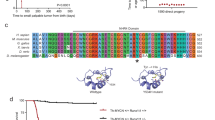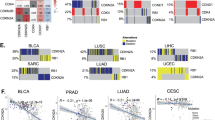Abstract
HUMAN retinoblastomas can occur both as hereditary and as sporadic cases. Knudson's proposal1 that they result from two mutational events, of which one is present in the germ line in hereditary cases, has been confirmed by more recent molecular analysis, which has shown both events to involve loss or mutational inactivation of the same gene, RB-1 (ref. 2). RB-1 heterozygosity also predisposes to osteosarcoma, and RB-1 allele losses are seen in sporadic lung, breast, prostate and bladder carcinomas3–7. RB-1 is expressed in most, if not all, tissues and codes for a nuclear phosphoprotein which becomes hypophosphorylated in the GO growth arrest state and in the Gl phase of the cell cycle2. To gain a further insight ino the role of RB-1 we and other groups8,9 have generated mice carrying an inactivated allele of the homologous gene, Rb-1 (ref. 10), by gene targeting11. We report here that young heterozygous mice do not appear abnormal and do not develop retinoblastoma at a detectable frequency. However, homozygous mutant embryos fail to reach term and show a number of abnormalities in neural and haematopoietic development. Broadly similar results are reported by the other groups8,9.
This is a preview of subscription content, access via your institution
Access options
Subscribe to this journal
Receive 51 print issues and online access
$199.00 per year
only $3.90 per issue
Buy this article
- Purchase on SpringerLink
- Instant access to full article PDF
Prices may be subject to local taxes which are calculated during checkout
Similar content being viewed by others
References
Knudson, A. G. Proc. natn. Acad. Sci. U.S.A. 68, 820–823 (1971).
Weinberg, R. A. Trends biochem. Sci. 15, 199–202 (1990).
Lee, E. Y. et al. Science 241, 218–221 (1988).
Yokota, J. et al. Oncogene 3, 471–475 (1988).
Stralton, M. R. et al. Br. J. Cancer 60, 202–205 (1989).
Shew, J. Y., Ling, N., Yang, X. M., Fodstad, O. & Lee, W.-H. Oncogene Res. 4, 205–214 (1989).
Cance, W. G., Brennan, M. F., Dudas, M. E., Huang, C.-M. & Cordon-Cardo, C. New Engl. J. Med. 323, 1457–1462 (1990).
Lee, E. Y.-H. P. et al. Nature, 359, 288–294 (1992).
Jacks, T. et al. Nature, 359, 295–300 (1992).
Bernards, R. et al. Proc. natn. Acad. Sci. U.S.A. 86, 6474–6478 (1989).
Capecchi, M. R. Science 244, 1288–1292 (1989).
Hooper, M., Hardy, K., Handyside, A., Hunter, S. & Monk, M. Nature 326, 292–295 (1987).
Smith, A. G. & Hooper, M. L. Devl Biol. 121, 1–9 (1987).
Moreau, J.-F. et al. Nature 336, 690–692 (1988).
Smith, A. G. et al. Nature 336, 688–690 (1988).
Williams, R. L. et al. Nature 336, 684–687 (1988).
Te Riele, H., Robanus Maandag, E. & Berns, A. Proc. natn. Acad. Sci. U.S.A. 89, 5128–5132 (1992).
Thomas, K. R. & Capecchi, M. R. Cell 51, 503–512 (1987).
Kaster, K. R., Burgett, S. G., Rao, R. N. & Ingolia, T. D. Nucleic Acids Res. 11, 6895–6911 (1983).
Adra, C. N., Boer, P. H. & McBurney, M. W. Gene 60, 65–74 (1987).
Hu, Q., Dyson, N. & Harlow, E. EMBO J. 9, 1147–1155 (1990).
Dive, C. & Wyllie, A. H. in Frontiers in Pharmacology: Cancer Chemotherapy (eds Hickman, J. A. & Tritton, T. T.) (Blackwell Scientific, Oxford, in the press).
Szekely, L. et al. Cell Growth Differ. 3, 149–156 (1992).
Te Riele, H., Robanus Maandag, E., Clarke, A., Hooper, M. & Berns, A. Nature 348, 649–651 (1990).
Mortensen, R. M., Conner, D. A., Chao, S., Geisterfer-Lowrance, A. A. T. & Seidman, J. G. Molec. cell. Biol. 12, 2391–2395 (1992).
Mansour, S. L., Thomas, K. R. & Cappecchi, M. R. Nature 336, 348–352 (1988).
McBurney, M. W. et al. Nucleic Acids Res. 19, 5755–5761 (1991).
Colbere-Garapin, F., Chousterman, S., Horodniceanu, F., Kourilsky, P. and Garapin, A.-X. Proc. natn. Acad. Sci. U.S.A. 76, 3755–3759 (1979).
Van der Lugt, N., Robanus Maandag, E., Te Riele, H., Laird, P. W. & Berns, A. Gene 105, 263–267 (1991).
Moore, G. E., Gerner, R. E. & Franklin, H. A. J. Am. med. Assoc. 199, 519–524 (1967).
Author information
Authors and Affiliations
Rights and permissions
About this article
Cite this article
Clarke, A., Maandag, E., van Roon, M. et al. Requirement for a functional Rb-1 gene in murine development. Nature 359, 328–330 (1992). https://doi.org/10.1038/359328a0
Received:
Accepted:
Issue Date:
DOI: https://doi.org/10.1038/359328a0
This article is cited by
-
brca2-mutant zebrafish exhibit context- and tissue-dependent alterations in cell phenotypes and response to injury
Scientific Reports (2022)
-
MYCN induces cell-specific tumorigenic growth in RB1-proficient human retinal organoid and chicken retina models of retinoblastoma
Oncogenesis (2022)
-
Differential regulation of mammalian and avian ATOH1 by E2F1 and its implication for hair cell regeneration in the inner ear
Scientific Reports (2021)
-
Mechanisms of early placental development in mouse and humans
Nature Reviews Genetics (2020)
-
Placentation defects are highly prevalent in embryonic lethal mouse mutants
Nature (2018)



